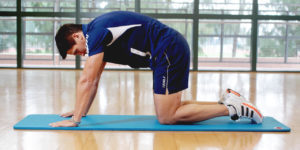Make sure you check out part one in this series – eccentric training – which should be the first part of your Triphasic training program.
Triphasic training is tailor-made for ruggers. It’s a weight training method that increases both strength and power. But, unlike a lot of non-specific bodybuilding type workouts, it targets not only your muscles but your nervous system too.
With Triphasic training, each periodized workout phase targets a specific type of contraction.
- Eccentric
- Isometric
- Concentric
By breaking a rep down into its constituent parts and emphasizing one at a time, it is possible to eliminate weak neuromuscular links and develop greater strength and power.
What is an isometric contraction?
What goes up, must come down, but before up turns into down, there is a point where movement stops. In strength training, this is called an isometric contraction. In an isometric contraction, there is muscle tension, but the joint angle does not change. In fact, isometric means same length or same distance. Examples of isometric contractions include:
- The plank abdominal exercise
- Walk squats
- A closely contested scrum where both sides are pushing, but no ground is won or lost
Isometric contractions bridge the gap between eccentric contractions and concentric contractions. They are the link that joins these two different contraction phases together. For example, when doing the bench press, you first lower the bar eccentrically and then push it back up concentrically. But, in between these two phases, it’s an eccentric contraction that brings the bar to a stop. If you don’t stop the bar from moving downward quickly and efficiently, at least some power will be lost. A powerful acceleration starts with a powerful deceleration.
Think about isometric contractions another way; when you run in rugby, you seldom do so in a purely straight line. You have to zig and zig past the opposition. Each time you change direction, you must stop your movement one way and redirect your movement another. Each change of direction is punctuated with a brief isometric contraction – that split second where you are motionless.
Most isometric gym exercises are low-tension and won’t do much for your strength. Planks and wall squats are classic isometric exercises. Both involve holding a specific position for an extended time. This type of training will increase isometric endurance but won’t do much for your strength or power. Ironically, you are stronger isometrically than you are concentrically or eccentrically. In other words, you can hold steady more weight than you can lift or lower. This is why most low-load isometric exercises involve such long holds – they are too darn easy!
In Triphasic training, the isometric contraction is loaded much more purposely, and with greater amounts of weight. This will have a significant impact on mid-rep strength and power. Focusing on the isometric phase of a rep will increase motor unit recruitment and rate coding.
Motor unit recruitment refers to the number of motor units you can use at the same time. Motor units are recruited sequentially and in order of size, from smallest to largest. Untrained individuals can only recruit a relatively small number of motor units at the same time. With training, and especially using heavy loads and isometric contractions, you can learn to recruit more motor units at the same time. This increases your potential for force production, allowing you to use more of your existing muscle mass.
Rate coding refers to the rate at which each of these fibers fire, which increases muscular tension. Muscle contractions are a series of twitches, and the faster this happens, the more force you’ll be able to generate. The tension in your muscles is the sum total of the number of twitches. The more twitches per unit of time, the higher the rate of force development will be.
Isometric training exposes your muscles to supra-maximal loads that affect both your muscles and your nervous system. Increased isometric performance will strengthen the link between eccentric and concentric contractions, and that will have a positive effect on all aspects of strength and power.
How to perform isometric contractions in Triphasic training
To increase isometric strength, you need more than a few sets of planks and wall squats. Instead, you need to apply the following guidelines to your workouts.
- Do isometric training first – because of the heavy loads and high intensities involved, isometric training should be done at the beginning of your program and only applied to a couple of exercises. Think quality over quantity.
- Use compound exercises – heavy eccentrics are best done with compound exercises like squats, bench presses, and pull-ups. Pick exercises that replicate sports-specific movements. For example, squats have a lot of carryover to rugby, whereas biceps curls do not.
- Descend quickly – to really hammer home the effect of isometric training, you should perform the isometric phase of any exercise as quickly as possible. Think “drop like a brick” rather than lowering under control. This will “shock load” your muscles and present them with a more challenging load to bring to a halt. Imagine pulling the weight down – that’s how fast the eccentric needs to be.
- Stop dead – pick the point where you want to apply the brakes and make sure you stop dead at that point. For example, when bench pressing, that could be one inch/three centimeters above your chest, or at 90 degrees of knee flexion in squats.
- Squeeze – once you have stopped moving, squeeze the target muscles to engage as many motor units as possible. There should be no movement, but that doesn’t mean you can relax. Try and generate as much static muscle tension as possible.
- Finish with an explosive concentric – after holding the load stationary for the prescribed time, fire the weight up as fast as you can. It might not move very fast, but that should be your intent.
- Rest 2-3 minutes between sets – you might feel recovered sooner, but you should rest 2-3 minutes between sets. This will ensure your nervous system is as ready as your muscles for your next set. Isometric training takes a lot out of your nervous system and, unless it is fully recovered, you will not be able to generate the necessary force for this type of training effective.
- Always use a spotter – you can support a lot of weight isometrically, and that means there is a real risk of being pinned by a heavy load. Use spotter who is ready to step in if you are unable to lift the weight yourself. For some exercises and training parameters, you’ll need to use a spotter to help you lift the weights into position.
Loading parameters for isometric training
The best way to implement isometric training is to introduce it gradually (preferably during the off-season) and after a phase of eccentric training. Use this chart to determine what weights to use and how long the isometric phase should be during each rep. Start at the top of the table (least intense) and work downward over the course of several phases of training.
*When working with 80-85% of 1RM, have a partner help lift the weight so you can focus more on the isometric part of the rep. You can apply eccentric training to a wide range of exercises, but the best choices, according to official Triphasic guidelines, are:
- Back squats
- Front squats
- Romanian deadlifts
- Bench press
- Pull-ups
- Shoulder press
- Single-arm dumbbell rows
For all isometric exercises you should:
- Adopt the proper setup position, inhale, and brace.
- Maintaining proper joint alignment, lower the weight as fast as you can – pull it down rather than just let it fall.
- On reaching the bottom of the rep, do your utmost to stop the load dead. Hold it for the prescribed time, maintaining maximal muscle tension.
- Fire the weight back up to the starting position.
- Exhale as you lift.
- Reset and repeat for the prescribed number of reps.
Here are two example workouts using the eccentric triphasic training method. Not all exercises involve isometrics. Other exercises are included for muscular balance and exercise variety. Use the loading/tempo/volume that is appropriate to your current phase of training.
Lower body isometric workout
Upper body isometric workout
While the isometric phase of Triphasic training will undoubtedly increase both strength and performance, it is not without risks. Rapidly lowering and then stopping a heavy load puts tremendous strain on your joints, muscles, tendons, and ligaments. Ruggers with pre-existing injuries should avoid this type of training. In addition, you should only attempt isometric training after having completed several weeks of the first part of Triphasic training – eccentrics. It also goes without saying that a full warm-up is essential for reducing your risk of injury.
Get yourself fired up for isometric training with pre-workout and recovery faster with post-game. In the third part of this series, we’ll take a look at the final part of triphasic training – concentric/reactive training.


